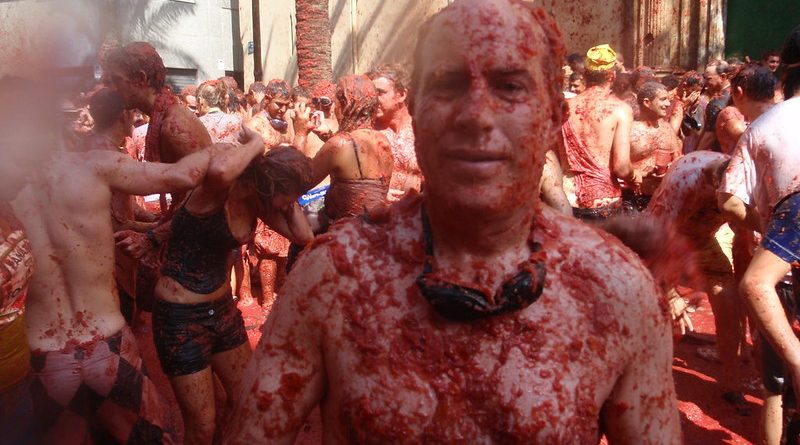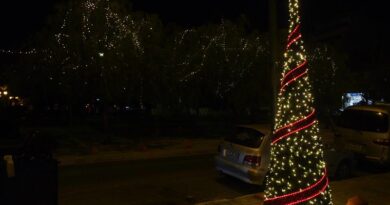La Tomatina Festival
Festival Essentials
When: Last Wednesday in August
Where: Buñol in eastern Spain.
Remember to bring: A liking for ketchup and a sense of fun!
Where’s the party? The world’s biggest food fight takes place at the Plaza Del Pueblo in the small town of Buñol in eastern Spain.
La Tomatina happens every year on the last Wednesday in August and is the highlight of a week-long local festival in honour of the town’s patron saint, San Luis Bertràn, and the Virgin Mary. The actual tomato throwing lasts for only two hours between 11am and 1pm
What’s It All About?
During the week leading up to the world famous tomato war, parades, fireworks, music, dancing and the paella cook-off contest draw visitors to Buñol for the annual fiesta. When the day of the great battle dawns, local shopkeepers diligently cover their shopfronts with sheets of plastic and twenty thousand local folk and tourists take to the streets, as trucks loaded with around 125,000 kilos of ripe ammo roll into the Plaza del Pueblo. Between 11am and 1pm, the streets are awash with juice, pavements are spattered with pulp and the participants transformed into walking, talking Bloody Marys.
As soon as the siren signalling the end of La Tomatina is sounded, the massive clean up operation gets under way. Water is pumped from a nearby Roman aqueduct and by mid afternoon there¹s barely any trace left of the messy mêlée that has taken place, much less the stench of fruit lingering in the streets.
The first Tomatina took place in 1945, but no-one seems to know exactly how it all started. Some say it began as a fracas between a group of friends, others claim the tradition was started at an anti-Franco rally. One of the most likely accounts is that brawling bystanders at a carnival parade seized the contents of a nearby vegetable stall, and began throwing tomatoes at their opponents. Initially the authorities did their best to ban what quickly became an annual battle, but in 1959 they eventually entered into the spirit of the event and it became an institution.
Whatever the real reason for the first tomato war, one things for sure: these days participants need no excuse to pelt each other with squashed tomatoes, they do it just for the heck of it!
Getting There
The nearest airport to Buñol is 30 miles away in Valencia. To get to the festival you’ll need to take a local bus or hire a car to drive there.
It is also possible to get to Buñol by train, either from Valencia or from Madrid.
Where To Stay
Accommodation in Buñol is limited. There are places to stay to suit all budgets in nearby Valencia, but it¹s still advisable to book ahead. For information on places to stay contact the tourist information at Valencia
Other Expenses
La Tomatina is the ultimate free for all. You don¹t need to a ticket to take part, just turn up and muck in.
Because most people who take part in the Tomatina come to Buñol on a day trip from Valencia, all you’ll need is money for your train or bus fare and perhaps for a bite to eat after the battle. As you’d expect, many of the participants are alcohol fuelled, even in the morning so you might want to bring some beer money with you too. A return ticket from Valencia by train costs around US$3, or US$2 by bus one way (there are no return bus tickets). See below for contact details for train and bus timetables.
Once You’re There
Don’t wear your holiday best and beware that anything white won’t stay clean and bright for very long. It¹s usually boys versus girls, and it rapidly becomes something of a wet t-short contest. People wearing baseball caps or carrying cameras are considered prime targets for everyone, so if you¹re determined to take pictures bring a see-though waterproof bag.
There aren’t many rules to tomato warfare, but those that do exist are in the interests of safety and public decency:
l) You can throw tomatoes and tomatoes only.
2) They must be squashed before you throw them, otherwise they can cause a nasty bruise.
3) Although the locals tend to rip each other’s clothing, it is officially forbidden and as a visitor, you will be expected to behave.
Local Attractions
Apart from La Tomatina, there isn’t much in Buñol to keep the visitor out of mischief. It is worth sending time in nearby Valencia, which is renowned for its lively nightlife and as the birthplace of paella.
The fantastic Las Fallas festival is held in Valencia in March, when the people parade through the streets with 15 metre high papier-mâché sculptures (known as fallas) which are constructed by local artisans and made to look like politicians or celebrities. These grotesque structures are set alight on the last night of the festival, amid much jollity and celebration.
Other highlights of the province of Valencia include a visit to the medieval fortress town of Morello, the Roman ruins at Sagunto and the historic palm gardens at Elx.
More Information
For more information about La Tomatina and the town of Buñol, contact the Ayuntamiento de Buñol Tel: +34 96 250 01 51 / Fax: +34 96 250 3083
For hotel accommodation in Valencia contact:
Tourist Info Valencia
C/ Paz, 48
46003 Valencia
Tel: +34 963 98 64 22 / Fax: +34 963 98 64 21
For train timetable and fare information contact Tel: +34 902 24 02 02 or visit www.renfe.com
For information on bus timetables contact Autocares Bunol
Tel: +34 96 349 14 25
don Quijote
An online guide to the culture and traditions of Spain.
Similar Events
Food is an integral part of many festivals around the world, but people are usually more interested in eating it, rather than throwing it at each other. There is another famous food fight which takes place three days before the beginning of lent in the town of Ivrea, in the Piedmont area of Italy – but here oranges are used as ammo.
The Spanish seem to have more festivals than any other country – certainly in Europe – and Tomatina is by no means the most bizarre. Each village will have at least one fiesta during the year. Because of the position of el toro (the bull) is Spanish culture, many of them will have some degree of tormenting animals. Contact the Spanish Tourist Office for more details.




